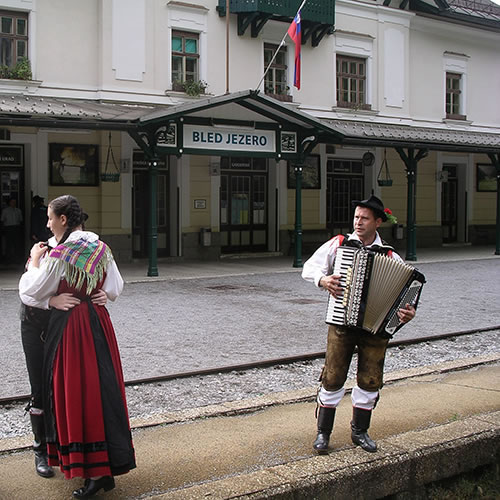April - June
The months of April and May are considered the first of two shoulder seasons across Slovenia. The snow begins to melt in April, and by May the Alpine regions are open for spring and summer activities such as whitewater rafting, hiking, and canoeing. The highest rain chances of the year occur in the months of April and May. More people visit tourist attractions nationwide, as prices continue to be affordable while the temperatures rise to more comfortable levels. Highs in Ljubljana average in the 60s and 70s in the spring, with lows in the 40s and 50s. Lake Bled is a tad warmer, with temperatures approaching 80 during the day and 60 at night by June. Maribor`s temperatures rise from the low 60s during the day in April to the mid-70s by June; lows are in the 40s and low 50s. Koper experiences temperatures similar to Ljubljana and Maribor around this time.
Holidays and festivals:
March or April: Easter Sunday and Monday (Velika noc, meaning `great night` -- as in Jesus Christ rising from the dead at the end of `that great night`). These days are not national holidays, but since Slovenia is a traditionally Catholic nation, everyone is given time off work, so there will be widespread business and infrastructure closures across the country on both days.
April 27: Day of Uprising Against Occupation (Dan upora proti okupatorju), commemorating the Liberation Front of Slovene Partisans who fought against Nazi German, Italian and Hungarian occupation of Slovenia during World War II. (national holiday in Slovenia)
May 1-2: May Day (Praznik dela) holidays. The equivalent of the American Labor Day, the worker is celebrated with parades and activities for families and children, and everyone gets time off work. (national holidays in Slovenia)
May or June: Whit Sunday (Binkoštna nedelja), or Pentecost (Binkošti), observed seven Sundays after Easter. A work-free day for the country, although not many would be working in government offices since the day is observed on Sunday.
Early June (two days): Medieval Days at Bled Castle, featuring sword fighting, a knight`s jousting tournament, archery, Medieval-era food, and a farmers` market.
June 8: Primož Trubar Day, honoring the man who is considered to be the father of the Slovene language. While a national holiday, it is not one that many people get off work. (national holiday in Slovenia)
June 11: Corpus Christi (Sveto rešnje telo in kri), a religious festival observed by Slovenian Catholics, some closures can be expected.
Mid-June (3 days): International Rowing Regatta, Bled, the largest rowing regatta in Central Europe, which has been held at Lake Bled for over 60 years.
Mid–June (3 days): Idrija Lace Festival, west of Ljubljana. Idrija lace is one of Slovenia`s best-known exports and there is an entire festival and market dedicated to the prized fabric.
Mid–June (5 days): Ljubljana Jazz Festival, one of the most noteworthy jazz festivals in the world, first presented in 1960 and held nearly every year since.
Mid–June (5 days): Jurjevanje Folklore Festival, southeast of Ljubljana in Crnomelj. It is the oldest cultural festival in Slovenia and is the place to be if you want to see traditional folk dancing and costumes.
June 25: Statehood Day (Dan državnosti), commemorating Slovenia`s independence from Yugoslavia on this day in 1991. Widespread nationwide business and infrastructure closures to be expected. (national holiday in Slovenia)
Late June and early July (two weeks): Festival of Lent, Maribor, a large performing arts festival featuring theatre, ballet, opera, and other live performances, as well as a big fireworks show.




